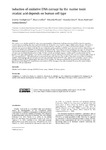Mostrar o rexistro simple do ítem
Induction of Oxidative DNA Damage by the Marine Toxin Okadaic Acid Depends on Human Cell Type
| dc.contributor.author | Valdiglesias, Vanessa | |
| dc.contributor.author | Laffon, Blanca | |
| dc.contributor.author | Pásaro, Eduardo | |
| dc.contributor.author | Cemeli, Eduardo | |
| dc.contributor.author | Anderson, Diana | |
| dc.contributor.author | Méndez, Josefina | |
| dc.date.accessioned | 2024-01-09T20:51:03Z | |
| dc.date.available | 2024-01-09T20:51:03Z | |
| dc.date.issued | 2011-03-01 | |
| dc.identifier.citation | Valdiglesias, V., Laffon, B., Pásaro, E., Cemeli, E., Anderson, D., Méndez, J., 2011. Induction of oxidative DNA damage by the marine toxin okadaic acid depends on human cell type. Toxicon 57, 882–888. https://doi.org/10.1016/j.toxicon.2011.03.005 | es_ES |
| dc.identifier.issn | 0041-0101 | |
| dc.identifier.uri | http://hdl.handle.net/2183/34785 | |
| dc.description | This is a manuscript versión of the article. | es_ES |
| dc.description.abstract | [Abstract] The marine toxin okadaic acid (OA) is the main representative of diarrhoeic shellfish poisoning (DSP) toxins. Its ingestion induces nausea, vomiting, diarrhoea and abdominal ache. It has also been found to trigger cellular and molecular effects at low concentrations. Its mechanism of action has not been described yet. Results of a previous study showed that OA can induce cytotoxic and genotoxic effects, both directly and indirectly, and modulations in DNA repair processes in three different types of human cells (leukocytes, SHSY5Y neuroblastoma and HepG2 cells). These effects varied depending on the type of cell and the concentration employed (Valdiglesias et al., 2010). On that basis, the ability of OA to induce oxidative DNA damage on the same cell types was investigated in the present study. To this end, the antioxidant enzymes catalase and N-acetylcysteine, and the human DNA- glycosylase hOGG1 were used in combination with the alkaline Comet assay. The cells were treated with a range of OA concentrations (5–1000 nM) in the presence and absence of S9 fraction. The results of this study showed that OA induces oxidative DNA damage directly in leukocytes, directly and indirectly in SHSY5Y cells, while it does not induce oxidative DNA damage in HepG2 cells. Combining the outcomes of both studies, the data showed that OA induces both cytotoxicity and genotoxicity, including DNA strand breaks and oxidative DNA damage, in the cells evaluated. However, the extent of these effects are cell type dependent. | es_ES |
| dc.description.sponsorship | This work was funded by a grant from the Xunta de Galicia (INCITE08PXIB106155PR). V. Valdiglesias was supported by a fellowship from the University of A Coruña | es_ES |
| dc.description.sponsorship | Galicia. Xunta; INCITE08PXIB106155PR | es_ES |
| dc.language.iso | eng | es_ES |
| dc.publisher | Elsevier | es_ES |
| dc.relation.uri | https://doi.org/10.1016/j.toxicon.2011.03.005 | es_ES |
| dc.rights | Atribución-NoComercial-SinDerivadas 4.0 Internacional | es_ES |
| dc.rights.uri | http://creativecommons.org/licenses/by-nc-nd/4.0/ | * |
| dc.subject | Okadaic acid | es_ES |
| dc.subject | Oxidative damage | es_ES |
| dc.subject | hOGG1 | es_ES |
| dc.subject | Comet assay | es_ES |
| dc.subject | Catalase | es_ES |
| dc.subject | N-Acetylcysteine | es_ES |
| dc.title | Induction of Oxidative DNA Damage by the Marine Toxin Okadaic Acid Depends on Human Cell Type | es_ES |
| dc.type | info:eu-repo/semantics/article | es_ES |
| dc.rights.access | info:eu-repo/semantics/openAccess | es_ES |
| UDC.journalTitle | Toxicon | es_ES |
| UDC.volume | 57 (2011) | es_ES |
| UDC.issue | 6 (May) | es_ES |
| UDC.startPage | 882 | es_ES |
| UDC.endPage | 888 | es_ES |
| dc.identifier.doi | 10.1016/j.toxicon.2011.03.005 |






